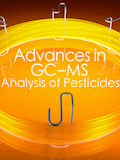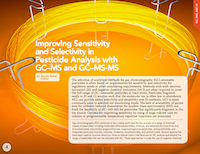Improving Sensitivity and Selectivity in Pesticide Analysis with GC–MS and GC–MS-MS
Spectroscopy E-Books
The selection of analytical methods for gas chromatography (GC)-amenable pesticides is often based on requirements for sensitivity and selectivity for regulatory needs or other monitoring requirements. Methods with both electron ionization (EI) and negative chemical ionization (NCI) are often required to cover the full range of GC–amenable pesticides at trace levels. Pesticides fragment easily in EI and CI sources such that the molecular ion is often low in abundance. NCI can provide added selectivity and sensitivity over EI methods. NCI is most commonly used in selected-ion monitoring mode. The lack of availability of parent ions for collision-induced dissociation for tandem mass spectrometry (MS) can limit the feasibility of GC–MS-MS for pesticides that significantly fragment in the ion source. Options for improving sensitivity by using of large-volume cold on column or programmable temperature vaporizer injections are presented. Read more
here
.

Best of the Week: Recognizing Albert A. Michelson, Studying Star Clusters, Elemental Analysis
May 16th 2025Top articles published this week include a new Icons of Spectroscopy column, a news story about the use of Fourier transform infrared (FT-IR) spectroscopy in gemology, and a Q&A interview about elemental analysis in pharmaceutical analysis.

.png&w=3840&q=75)

.png&w=3840&q=75)



.png&w=3840&q=75)



.png&w=3840&q=75)











